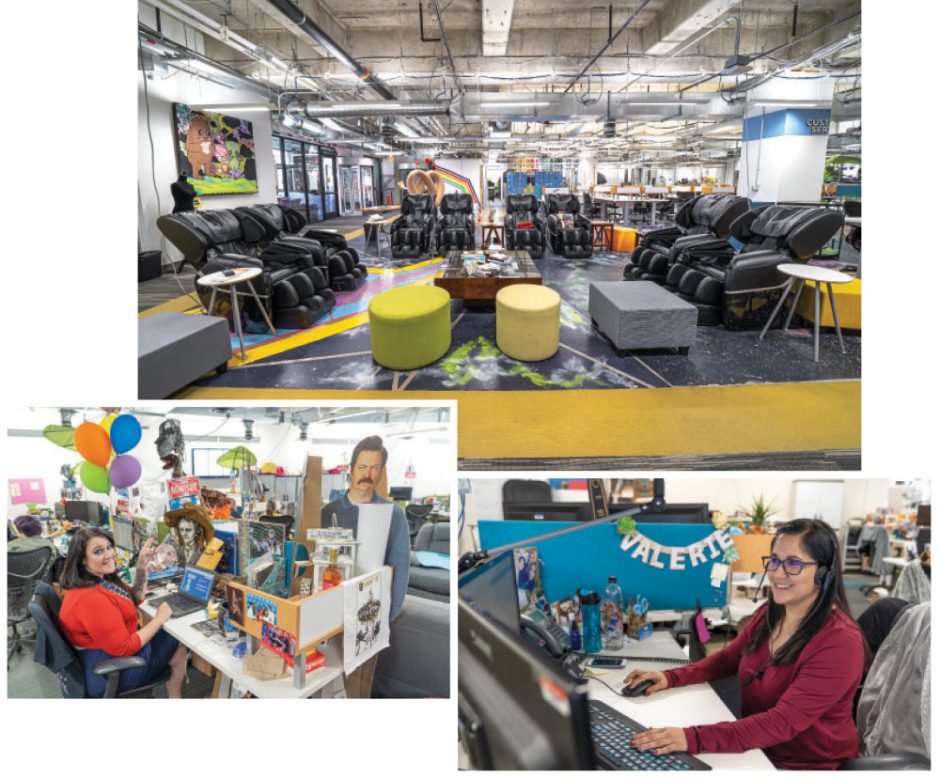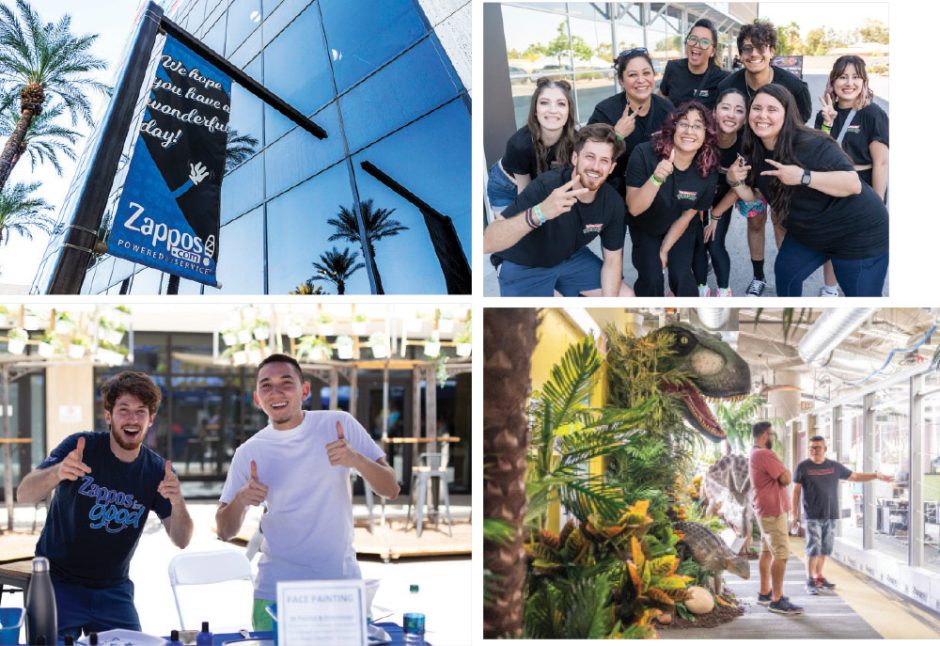
To fully appreciate the seismic impact Zappos has had not just on the footwear industry but on the way the world shops, it helps to do a little time travel. The year is 1999. Ecommerce is in its infancy. If consumers can’t find shoes in the right size, style, and color at a retailer in their area, they’re generally out of luck. But that’s about to change, thanks to a frustrated shopper-turned-entrepreneur and a visionary investor-turned-partner.
 It started with a pair of Airwalk Desert Chukka boots—or, rather, the lack of them. Software engineer Nick Swinmurn got so frustrated about being unable to find the boots he wanted at a San Francisco mall that he quit his day job and created an ecommerce concept he called shoesite.com. Swinmurn felt sure online sales were the next big thing, but the venture capital firms he approached for backing were skeptical. Would people really buy shoes through the World Wide Web? Not likely, they reckoned.
It started with a pair of Airwalk Desert Chukka boots—or, rather, the lack of them. Software engineer Nick Swinmurn got so frustrated about being unable to find the boots he wanted at a San Francisco mall that he quit his day job and created an ecommerce concept he called shoesite.com. Swinmurn felt sure online sales were the next big thing, but the venture capital firms he approached for backing were skeptical. Would people really buy shoes through the World Wide Web? Not likely, they reckoned.
Then he met Tony Hsieh and Alfred Lin, two Harvard grads who’d made a bundle in Silicon Valley selling an online banner ad platform called LinkExchange to Microsoft and founded a VC firm called Venture Frogs. Hsieh’s first instinct was to agree with the other VCs who’d turned Swinmurn down. “Selling shoes online seemed like a poster child for bad internet ideas,” he once recalled. Swinmurn countered by pointing out that shoes were a $40 billion market in the U.S. and five percent of them were already being sold by mail order. Venture Frogs decided to invest, and Hsieh became co-CEO of the company, which was rechristened with the catchier name Zappos, short for zapatos, or shoes in Spanish.
Of course, Hsieh did more than fund Zappos. He was the architect of the company’s legendary high-touch, customer-first culture and beloved polices like free shipping, free returns (up to a year after purchase), and an ultra-phone-friendly business model. The business’s 800 number popped up on every Zappos web page; shoppers could call it 24/7 and reach a team member who would answer questions and patiently provide assistance. (One legendary call lasted almost six hours.) Hsieh also ushered in a quirky, egalitarian, happiness-first work environment that embodied one of the brand’s core values: “Create fun and a little weirdness.”
Front Runner

Zappos proved to be far more than a business innovator; the company radically reinvented the footwear shopping experience. Their warm-fuzzy, customer-is-always-right approach took the fear out of an unfamiliar format for millions of people buying shoes online for the first time—and their loyalty-building shipping and return policies became industry standard for countless other etailers (at least for a while).
“It’s easy to forget that there was no Amazon as we know it now when Zappos was founded, so it was a foreign concept to sell shoes online. They were trailblazers,” says Steve Mahoney, senior vice president at Samuel Hubbard, who has worked with Zappos for more than two decades (beginning at Clarks) and says the company is still one of his biggest customers. “Couple that with Zappos’ unique approach to customer service, and you have a sort of historical landmark in footwear.”
“Florsheim has partnered with Zappos since its launch 25 years ago, back when Zappos was based in San Francisco,” says Beverly Goldberg, vice president of Florsheim. “Despite doubts about the viability of e-commerce, particularly for shoes, we joined in, and Florsheim has enjoyed steady growth with Zappos ever since.”
“I remember the first meeting with the Zappos buying team early on when I was working for Candie’s,” says Gary Van Ackeren, now national sales manager for Dingo. “Three former Nordstrom buyers visited our New York office during FFANY. They were dressed in three-piece suits and had a set of business plans to try to convince us that selling product from a photograph online was going to be very big.”
How right they were. Retail ecommerce sales in the U.S. reached $289.2 billion in Q1 2024, according to U.S. Census Bureau data. Globally, ecommerce is expected to hit $6.3 trillion this year, per data from the forecasting firm EMarketer.
But in the quarter century since Zappos helped to pioneer the online age, countless etailers have come and gone. Meanwhile, Zappos is still going strong as it celebrates its 25th anniversary in 2024. It’s quite the feat, or should we say feet?

That success has a great deal to do with holding true to the company’s original values of delivering happiness and treating customers right, says CEO Scott Schaefer. Service is still Zappos’ north star. “When we started out, we were the sole footwear retailer online. Now, virtually every brand has an online presence, but Zappos is still around doing what we do best—provide exceptional customer service and sell shoes,” says Schaefer, who has been with Zappos since 2008 in roles from operations to strategy to finance. “This milestone is a testament to the value of consistently putting our customers first. We’re customer-obsessed. We go above and beyond to bring added value to them and to online shopping as we evolve and innovate.”
And customers aren’t the only ones who benefit from the Zappos mindset. “We deliver exceptional service to our brand partners, vendors, and of course, each other—Zappos employees,” Schaefer adds.
While prescience and business savvy fueled the company’s meteoric rise, in many way the good vibes approach is what sustained its flight path and made the brand iconic.
“The Zappos culture was so profound that big corporations would schedule field trips from all over the country to visit the Zappos campus,” Van Ackeren recalls. “Tony was deeply passionate about Zappos’ culture and the mission of delivering happiness. He ensured that everyone in the organization felt supported in a fun and engaging work environment.”
“The leading attribute to me is a constant theme of kindness,” says Mahoney. “From the top down and bottom up, you deal with nice people who mean well, work hard, and strive to do the right thing.”
Trial and Error
Proving that even brilliant business minds don’t get everything right the first time, Zappos’ leadership team took a few missteps before they hit their stride. In the early days, the company fulfilled orders with drop shipments, relying on brands to send products directly to Zappos customers. Unfortunately, the brands didn’t give Zappos up-to-the-minute information about their inventory, so the shoes customers ordered weren’t always available. Result? Annoyed customers. Compounding the problem was the fact that brands’ warehouses were scattered around the country, and they all had different shipping times, so customers couldn’t be sure when they’d receive their order. Result? More annoyed shoppers.
To solve the problem, Zappos abandoned drop-shipping and started buying inventory from manufacturers. At first, they outsourced warehousing and shipping. It was a cost-effective approach, but the firm was slow to fill orders, which further alienated shoppers.
“As an ecommerce company, we should have considered warehousing to be our core competency from the beginning,” Hsieh wrote in a Harvard Business Review article in 2010. “Trusting that a third party would care about our customers as much as we did was one of our biggest mistakes. If we hadn’t reacted quickly by starting our own warehouse operation, that mistake would eventually have destroyed Zappos.”
Zappos survived the dot.com crash and overcame a number of challenges to reach merchandise sales of $70 million in 2003, but it was still a startup in many ways—long on growing pains and short on cash. In 2004, the business found itself was at a crossroads. Providing top-notch customer service had always been Zappos’ lodestar, but attracting staff for call centers was a constant struggle in the San Francisco Bay Area because the cost of living was too high to make that kind of work sustainable. They’d been burned by outsourcing already, so subcontractors were out of the question.
Viva Las Vegas

After much debate, Zappos made a bold move: Headquarters would relocate to Las Vegas, where all-night work was common and applicants for call center jobs were plentiful. (The work paid quite livable wages by the city’s standards.) The executive team broke the news to the staff and offered to pay moving expenses for anyone who agreed to come along. To their delight, 70 of the 90 team members agreed.
Zappos also made it a policy to train every new hire, regardless of job title, as a call center rep. This helped the entire team develop an appreciation for the work the call center did and underscored the value the company placed on phone interactions. The way Hsieh saw it, most customers called at some point, so why not seize the opportunity to create a “WOW” moment? A positive interaction with a rep would leave shoppers feeling good about Zappos—and that would likely build loyalty as well as referrals (a.k.a. free word-of-mouth marketing).
Bucking the standard approach, Zappos had no pre-written script for its reps. Nor did they push anyone to upsell or pressure reps to field as many calls as possible in a shift. On the contrary, Zappos encouraged team members to take as long as they needed with each caller. And reps were free to let their personality shine through. They could be creative. And funny. The goal was to make an emotional connection with the person on the other end of the phone.
The plan worked. In true Zappos fashion, call center reps did everything from sending a sympathy bouquet to a customer who missed the window to mail back a pair of shoes due to a death in the family, to figuring out where one could order pizza at 3 a.m. in Santa Monica. (Hsieh shared the latter anecdote, an impromptu “test” he and some other attendees at a sales conference cooked up to gauge how stellar the call center really was, in his 2010 book Delivering Happiness: A Path to Profits, Passion, and Purpose.)
Zappos’ headquarters, in the renovated former Las Vegas City Hall, became as iconic as the call center. “I vividly recall visiting the Henderson office when Zappos relocated to Nevada. The layout was astonishing—Tony’s ‘office’ was right in the open, situated in the middle of everyone else,” Dingo’s Van Ackeren says. “The building featured dedicated rooms for new moms, spaces for people to recharge, areas to embrace new ideas, and even game rooms scattered throughout. At times one would have to dodge golf balls rolling down the halls.”
“They were just so unique. When you would visit their office, it was fun, buzzing, and interesting. I never saw anything like it prior to or since,” Samuel Hubbard’s Mahoney recalls.
Zappos’ brand partners have fond memories of the firm’s epic parties.
“Every August during the shoe show, they hosted an incredible party, inviting everyone who played a role in their success,” says Van Ackeren. “My favorite was a circus-themed event that featured live animals roaming the area, multiple stages for circus acts, and Tony himself greeting everyone at the entrance, dressed as an animal, always delivering happiness!”
Headquarters is still a wonderland of whimsical amenities designed to brighten the work day and inspire happiness. There’s an arcade, an auditorium for movie screenings and game watch parties, a nap room with recliners surrounded by a giant aquarium, a collection of massage chairs, a gym, and a rooftop patio with mini golf, among other quirky perks. (It’s possible to book virtual and in-person tours.) The building is also LEED-Gold certified, reflective of Zappos’ commitment to sustainability. Employees are encouraged to leave campus and explore downtown Vegas, and events are often held at local restaurants and clubs.
Forward Thinking
In 2008, Zappos hit $1 billion in gross merchandise sales. But with expenses outpacing revenue, the company was forced to reduce workforce by eight percent. The following year, Amazon—an upstart online bookseller back in the shoesite.com days, but now a colossus—offered to buy Zappos for a reported $1.2 billion, the largest acquisition in Amazon’s history. Hsieh agreed. The deal gave Zappos access to Amazon’s considerable resources while allowing Zappos to keep being Zappos, operating largely independently and maintaining its own headquarters. (Hsieh remained CEO until 2019 and died in a house fire in 2020.)
For its part, Amazon—which had tried and failed to develop its own shoe and accessories site—took several pages from the Zappos playbook, adopting the company’s quick shipping and frictionless return policy as well as its customer-first mentality. At the time, Jeff Bezos told the press, “Zappos has a customer obsession, which is so easy for me to admire….I get all weak-kneed when I see a customer-obsessed company.”
As an Amazon subsidiary, Zappos expanded and diversified product offerings, adding apparel and other goods. (Today, the platform features millions of products from more than 1,500 brands.)
In 2017 came the launch of Zappos Adaptive, a program catering to customers with special needs. The concept originated with a call from a grandmother in search of shoes for her grandson, who was unable to untie shoelaces. Research revealed an underserved community in need of functional, fashionable products, so Zappos started offering footwear tailored to the adaptive market, with products like easy-on and orthotic-friendly shoes, footwear for customers who needed a single shoe or two shoes in different sizes, and more. The mix includes products from well-known brands like Nike, Converse, and New Balance.
“We’ve also gotten more committed to the performance footwear space, and with that, had a lot more on the ground time with folks at races nationwide,” Schaefer adds.
Zappos has upped its philanthropy game, too. “One of the highlights of Florsheim’s partnership with Zappos is the Zalloween events,” says Goldberg of Zappos’ annual Halloween-themed golf event, created in 2009 to raise money for charity. “They’ve been a fun and memorable way to team-build and increase vendor community camaraderie over the years.”
“Zappos mission is still to deliver WOW,” says Schaefer. “We’ve always experimented and pushed the envelope, and our eyes are always open for chances to surprise and delight our customers.” He cites the company’s partnership with the Savannah Bananas exhibition baseball team as an example. “It was an unexpected sponsorship move that has resulted in unique, fun merchandise for the team and its fans, including the Savannah Banana–branded Crocs available on Zappos.”
Efficiency and shipping speed are also focal points. “We’ve streamlined our warehouse and shipping and receiving network to be closer to more customers than ever before, allowing us to reach them in the timeliest way possible,” Schaefer explains.
Technology, too, is key. “I see more advances in the onsite experience thanks to our tech team and all the advancements coming the industry’s way on that front,” he continues. “We’re experimenting with AI for shoe pairing and outfit recommendations, and we’ve dipped our toes in Virtual Try-on technology. I’m excited to see what additional service offerings we can bring to our customers through the site as we push more boundaries.”
But no matter how high-tech Zappos becomes, the human touch will always be at the heart of the business. “Tony Hsieh cared about people and put them first,” says Schaefer. “Zappos is still a people-first company and always will be. In a time when people are still feeling the effects of distance and potential isolation, Zappos and our amazing Customer Loyalty Team are a constant, there for you 24/7—to tell a joke, be a friendly voice, maybe order you a pizza and, of course, help with all your Zappos customer needs.”



